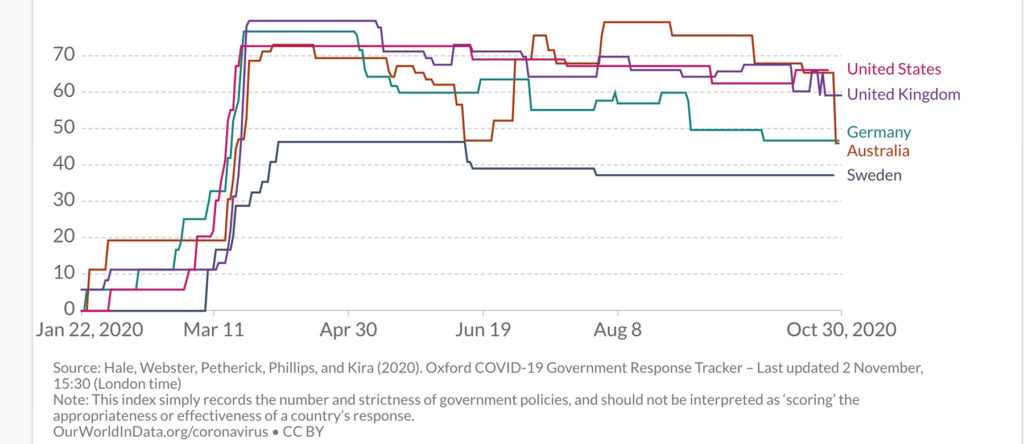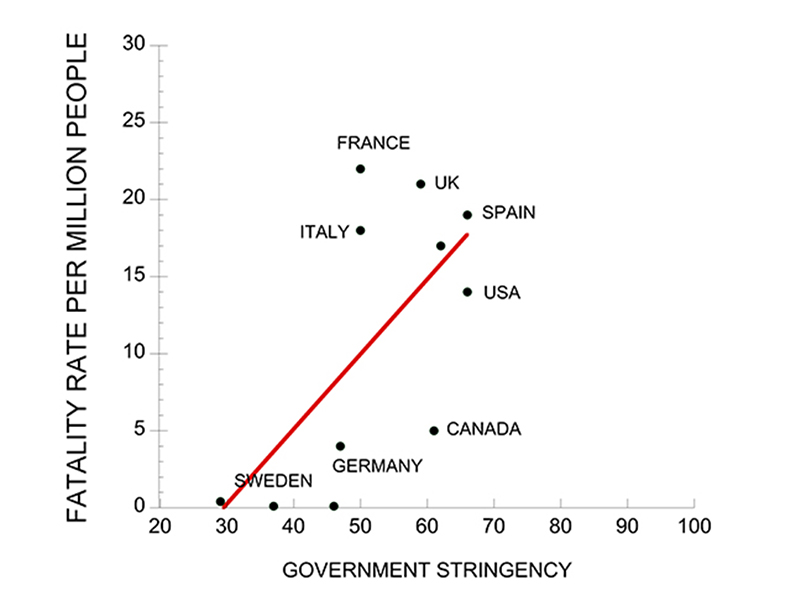Are Lockdowns Effective in Preventing Coronavirus?

Back in June, when California began to emerge from a severe lockdown of its economy, I wrote what I said would be my last commentary on the corona virus. I lied.
As Germany, France, and Great Britain return to serious lockdowns, and drumbeats call for greater lockdowns in the United States, the debate over the effectiveness of shutdowns is reaching a new level. Many epidemiologists point to a dangerous increase of coronavirus cases and deaths if greater restrictions aren’t put in place. Others, using the same models with different assumptions, tell a different story – arguing that lockdowns aren’t effective and, in the worst case, may even cause greater loss of life than those from the virus the lockdowns are to protect us from.
So how do we make sense of the public policy debates? We probably can’t, at least until this is all over. But there are some things we might learn from history – and even recent history now that we have 8 months behind us.
It is instructive to revisit how we handled the Spanish flu pandemic (1918-1920). New York City relied on its investment in public health infrastructure, setting up a rigorous system to identify and quarantine the sick. Infected individuals were quarantined at home or, if they lived in group housing, were quarantined in public health facilities set up for the pandemic. A deliberate decision was made to keep the schools open, reasoning that children would be safer in school than left alone at home. Businesses were kept open, although opening hours were staggered to reduce crowding on the mass transit system. Theaters were also kept open, although at reduced capacity. There was no mandatory mask ordinance, but photographs from the era show that mask wearing was prevalent.
Seattle took a more restrictive approach, implementing a complete shutdown of restaurants, bars, businesses, and schools. They also mandated the wearing of masks. San Francisco, to the south, shut down early and hard – closing businesses and schools and mandating masks.
So how did they do? New York had the lowest death rate of the three cities even though it had the highest population density. Seattle was a close second. The worst by almost an order of magnitude was San Francisco. It made the mistake of opening up too early and experienced a second, more deadly wave of the virus.
If we can draw any conclusion it is this – the mistake is to declare victory too early. Other than that, it appears there was little difference between a full lockdown and a targeted approach of quarantining the sick and improving social distancing.
It may be too early to have learned anything from our approaches to coronavirus. Nevertheless, it is informative to compare a country’s death rate to its efforts at mitigating spread. For this, we can turn to the Oxford Government Response Stringency Index, which evaluates a country’s response in terms of measures such as school and workplace closures, travel bans, etc. It is not meant to grade the effectiveness of the strategies. However, it is irresistible to compare the Stringency Index to a country’s death rate from the coronavirus.
Using death rate data from the past seven days – through November 2 – the lowest rates are recorded by Australia and Sweden (0.1 deaths per million). Australia has just opened after a several months lockdown (Stringency Index 80) while Sweden continues its more open strategy (Stringency Index 37). At the high end of death rates, France (22 deaths per million) and the United Kingdom (21 deaths per million) have maintained a conservative SI (50 – 59) until recently (they are now, or soon to be, in lockdown again).
How is the United States? Surprisingly, we have maintained a high Stringency Index (66) since the beginning – most of our population remains under strict guidelines with theaters, school, and workplace closures and strict social distancing guidelines. The following graph is an indication of the stringency of control measures in several countries from the beginning of the outbreak. Of surprise to me is the realization that the United States was quick to respond and remains vigilant in its response to the virus. Our death rate in the last week is 14 per million, and while still too high, is lower than many of our European counterparts.
Is there a relationship between the stringency of a government’s response and death rates in its population? It is a weak correlation, but, paradoxically, the death rate increases with the increasing severity of the lockdown. This is shown below for the stringency index reported on November 1 with the seven day average of deaths per million people.
Perhaps this apparent anti-correlation is caused by a lag between rising cases and government response. However, accounting for a lag in response by re-graphing the data with stringency measures in place a month prior to taking the death rate data does nothing to change the results.
A final consideration is the impact of stringency measures on GDP. Here, there was a small correlation between severity of the lockdown and economic contraction. Two noticeable outliers were the United States (2020 GDP estimate – 2.9%) and the United Kingdom (2020 GDP estimate – 21.5%). No country escaped the negative financial impact, but the United States did better Europe, Canada, and Australia.
If there is one lesson to be had from all of this data, it is that it is a difficult time to be making public policy. We know that total lockdown will slow the spread of the virus, but it is unsustainable. Sweden’s approach, while initially flawed by failing to ad protections for the vulnerable (e.g., the elderly and those with co-morbidities), seems to have had the most positive outcome in the later stages of the virus. While Swedens total death count from the coronavirus is slightly higher than France, it is not experiencing the second wave that is now hitting the rest of Europe. Perhaps protecting the vulnerable while mandating social distancing for the rest of us is a good compromise solution. One thing is certain, however, you cannot afford to turn your back on this disease.
Now, what does all of this mean for our winery operations? Not much. I expect that tasting rooms in Alameda County will remain closed through the end of the year out of an abundance of caution. We can live with that for now. Hopefully, a new year will bring us a vaccine and better treatments so that we can provide everyone a safe and enjoyable tasting experience.




